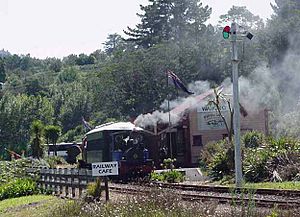Goldfields Railway facts for kids
Quick facts for kids Goldfields Railway |
|
|---|---|

The Goldfields Railway's 0-4-2 Peckett steam locomotive with a train at the Waikino terminus in 2005.
|
|
| Locale | Karangahake Gorge, Bay of Plenty |
| Commercial operations | |
| Name | Part of the East Coast Main Trunk Railway |
| Built by | New Zealand Government Railways |
| Original gauge | 1,067 mm (3 ft 6 in) |
| Preserved operations | |
| Owned by | Goldfields Railway Incorporated |
| Stations | Two |
| Length | 6 km (3.7 mi) |
| Preserved gauge | 1,067 mm (3 ft 6 in) |
| Commercial history | |
| Opened | 1905 (to Waihi) |
| Closed | 1978 (Paeroa - Tauranga) |
The Goldfields Railway is a special kind of railway that keeps old trains running. It travels between Waihi and Waikino in the Bay of Plenty area of New Zealand's North Island. This railway uses a part of the old East Coast Main Trunk Railway line. That big railway line changed in 1978 when the Kaimai Tunnel opened, making this section no longer needed.
In 1980, a group called the Goldfields Steam Train Society was formed. Their goal was to save this part of the old railway line. Later, in the mid-1990s, the society changed its name to the Goldfields Railway.
Contents
A Journey Through Time: The Railway's History
The railway line you see today was first built through the Karangahake Gorge. It was called the Waihi Branch line. This line started from Paeroa and went to Waihi. Its main purpose was to help with the busy mining work happening in Waihi.
At first, this line was not meant to be a main railway route. But after many studies, it became part of the East Coast Main Trunk line. This happened in 1928, connecting Waihi to Tauranga, Te Puke, and eventually Taneatua.
This route was quite long and winding. Because of this, roads became a more popular way to travel. However, more goods were being shipped from Tauranga's port. This meant the Karangahake Gorge route became very busy.
So, a new, more direct route was needed. This led to the building of the Kaimai Tunnel. When the tunnel opened on September 12, 1978, the old Karangahake Gorge route was closed. Most of it was taken apart in the 1980s. But the Goldfields Railway saved 6 kilometres (about 3.7 miles) of track between Waihi and Waikino.
Exploring the Preserved Line
In Waihi, you can still see many parts of the old station. The main station buildings are protected by Heritage New Zealand and the Rail Heritage Trust. Some old freight buildings are gone, but the goods shed and several railway houses remain.
The railway line to Waikino is 6 kilometres long. It crosses a few bridges. One special bridge is the only private railway bridge that goes over a state highway in New Zealand.
The station in Waikino is not the original one. It used to be the station in Paeroa. It was moved to Waikino in 1990. This happened just before the railway through Paeroa to Thames closed in 1991. Today, the Waikino station is a cafe. It also connects the railway to a walking path through the Karangahake Gorge.
Meet the Locomotives
The Goldfields Railway has many different locomotives, which are the engines that pull the trains. Most of them are small diesel locomotives. These were often used in factories or for moving wagons around in railway yards.
Here are some of the locomotives you might see:
- A Baguley-Drewry diesel locomotive, built in 1968.
- A Peckett steam locomotive, built in 1938.
- A Price petrol locomotive, built in 1944.
- Two TR class diesel locomotives, both built in 1948. They have slightly different designs.
The railway also has smaller vehicles called velocipedes and motor trolleys. These are mostly used by staff to check the tracks and do maintenance work.
Sometimes, other steam locomotives visit the Goldfields Railway. For example, during Easter in 2006, a special steam locomotive called Y 542 visited. It came from the Museum of Transport and Technology to celebrate over 100 years of the railway in Waihi.
The Rolling Stock: Carriages and Wagons
The Goldfields Railway also has a collection of rolling stock. This includes both passenger carriages and freight wagons.
The railway focuses on preserving three old passenger carriages. These were built in 1911, 1913, and 1931. There is also an open passenger carriage built in 1993. This carriage is attached to an older frame from 1911. A guard's van is also part of the collection.
The railway has many different freight wagons. These are currently waiting to be restored. The collection also used to include a large railway crane. This crane, called Cowans-Sheldon 10-tonne railway crane NO 227, was built in 1937. It was moved to the Ferrymead Railway in 2009 to be fixed up and used again.
How the Railway Operates
Trains run three times a day from Waihi to Waikino and back. Each trip takes about 30 minutes. There is a 15-minute stop at Waikino before the return journey.
Unlike many other railways, the Goldfields Railway allows pets on the train! They can ride in the open carriage, which is part of every train trip.
The railway also offers special train rides for groups. They often host themed rides to help raise money for local groups and charities.

